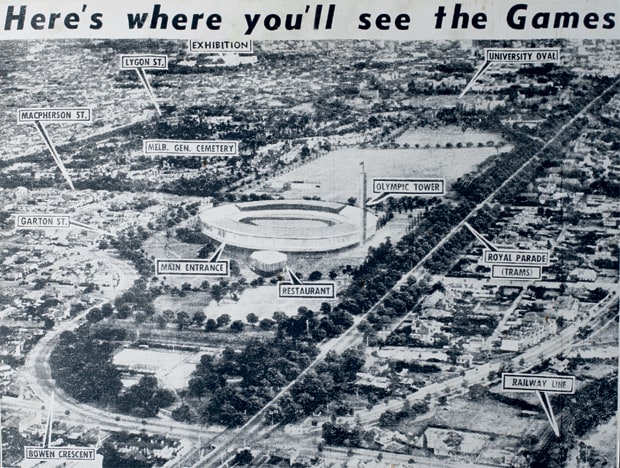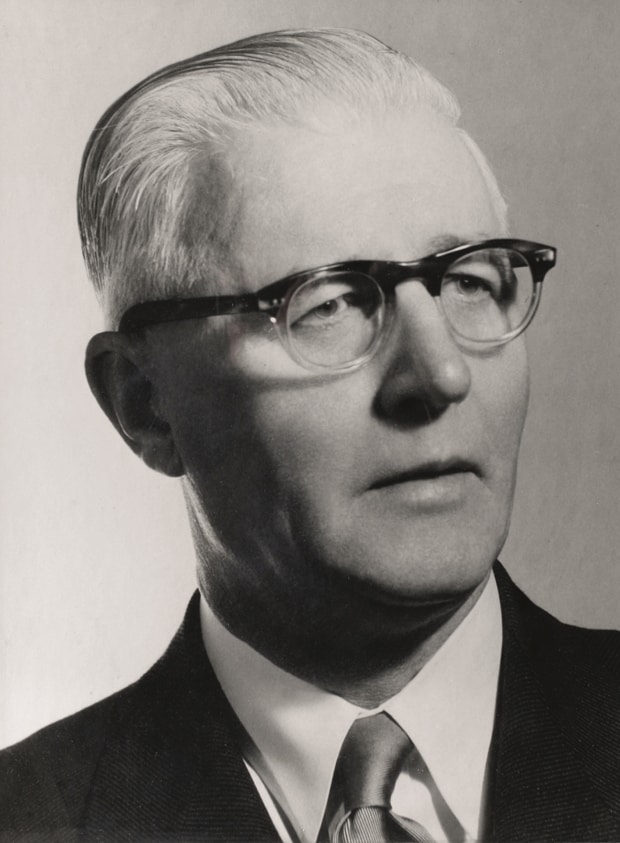Sixty years ago this November, high atop the MCG’s old Northern Stand, the late Ron Clarke put fizzling flame to cauldron to open the Games of the XVI Olympiad.
Clarke burnt his arm in the process, but damage was minor and superficial – and yet for Carlton President Ken Luke, the scars of the 1956 Melbourne Olympics would run deep and linger a lifetime.
Acknowledged in The Argus as a “philanthropist and sportsman”, it was KG Luke who audaciously secured the 1956 Games for his beloved Princes Park – only to be thwarted by the Melbourne Cricket Club through the intervention of the then Premier John Cain senior.
Today, with the assistance of the City of Melbourne, and football club minutes of the time, the story behind the story can be told with greater clarity.
In early 1952, Princes Park firmed as the Olympic venue when the Royal Melbourne Showgrounds were considered unsuitable and the MCG was refused on the grounds that the conversion of the arena was considered “engineeringly impracticable”.

A newspaper report on the proposed Princes Park precinct, 1952. (Image: Supplied)
On March 24 of that year, the Melbourne City Council agreed that the cost of making the Carlton Ground available as the main stadium should be borne by the Federal Government (50%), the state Government (25%) and the Melbourne city Council (25%), the council’s proportion of the cost being expected at that time to be in the vicinity of £300,000.
Under the proposal,
• Carlton would stage the Melbourne Olympiad in a redeveloped 100,000-seat stadium at Princes Park, with the now heritage-listed Ald. Gardiner Stand to be demolished;
• cost for the Princes Park redevelopment, then estimated at £1.2million would be met by the Federal Government (50%), the State Government (25%) and the Melbourne City Council (25%);
• Carlton home matches would be staged at Coburg Oval for the duration of the four-year redevelopment.
Confirmation of Princes Park’s hosting of the Games was not surprisingly met with much fanfare, as was reported in the club’s 1952 Annual Report.
It was a great day for the supporters of the Carlton Football and Cricket Clubs when after months of conjecture, discussion and hope, it was announced that Carlton Recreation Ground had been chosen as the site for the Olympic Stadium for the 1956 Games.
The decision was a personal triumph for the President, Mr. K. G. Luke, who worked untiringly with a faith shared by few others, to have the undoubted advantages of Princes Oval recognised by the authorities; he was very ably supported by Vice-President Bill Townsend. The supporters of the clubs will always be indebted to these gentlemen for making it possible to enjoy, in future years, the benefits and amenities of the best ground in the Southern Hemisphere.
With the site decided, it was only natural that Mr. Luke be asked to take a prominent place on the committee to construct the stadium and he was unanimously appointed Vice-Chairman of the Organising Committee. To better acquaint themselves of the latest developments and trends in the construction of stadia, both the Chairman, Mr. A.W. Coles, and Mr. Luke visited the Games at Helsinki, Britain, the U.S.A. and The Continent in search of the latest information and ideas.
On their return, the office of Frank Heath was chosen as the architects, after a world-wide competition for designs, to carry out the work, and Mr. Heath’s lieutenants, Messrs. P. Fielder and G.M. Hirsch, have already established themselves at the ground. Demolition of the present buildings will take place in the new year.

An artist's impression of the exterior of the Princes Park ground. (Photo: Supplied)
Undoubtedly, there will be some sadness among our older supporters when the buildings start to tumble; these house so many past glories and happy memories – and of course a few disappointments. The Gardiner Stand, the high mounds, and other old buildings at the ground were not easily gained and have stood for so long as monuments to the hard work and vision of the pioneers – many of whom are still with us today. But as the new structures rise from the rust and rubble of the old, they too, can take pride in the knowledge that it was their persistence in winning a permanent ground for the ‘Blues’ over half a century ago that has made the Olympic Stadium at Princes Park possible.
The Melbourne City Council voted 9 to 1 that the Carlton Ground should be the main stadium, the council’s representatives having moved and seconded the motion.
It was subsequently determined that costs for redevelopment of the stadium would be “considerably in excess of that originally anticipated”.
At subsequent meeting called by the then Premier John Cain, it was resolved that the Melbourne Cricket Ground authorities had altered their previous views, “and declared that the ground would now be made available for the Games.
On February 2, 1953, barely a year after the Carlton ground was confirmed as the Olympic venue, the MCG was unanimously declared the beneficiary of a venue switch. This followed an announcement by the Premier that no State Government funding would be available for the Carlton stadium.
The games control committee chairman AW Coles told reporters “I am very sorry we are not going to get a nice stadium at Carlton, but the Premier has decided that finance will be available only for the MCG”.
“We must, therefore, all get behind this and try to gain approval of the IOC so that Melbourne will not lose the games,” he said.
According to John Cain senior, the overall cost of staging the games in Melbourne would be £850,000, which included £300,000 for bringing the MCG to Olympic standard, £350,000 for the Olympic pool and about £200,000 for other works, including the cycling track. This, he said, amounted to £400,000 less than the original amount agreed upon the previous year, with the Federal Government to commit 50% in funding, and the State Government and City Council 25% each.
Interestingly, the Prime Minister and MCG Trustee Sir Robert Menzies, whose allegiance to Carlton and friendship with Ken Luke were lifelong, left what was reported as a heated 2½ hour meeting without making comment.
The following appeared in Carlton’s 1953 Annual Report, beneath the headline OLYMPIC GAMES AND THE CARLTON GROUND
Fortunately, all references in the last annual Report to the possibility of the Olympic Games being staged at the Carlton Oval were prefaced by the phrases “almost certain” or “most likely”. This was a most necessary precaution for even at that stage, and despite the progress made by architects in the planning of the stadium, most of the club officials knew that certain forces, jealous of the Carlton project at the beginning, were at work to have the site changed. This was more in evidence when it was known that the Carlton plan was based on catering for over the 100,000 persons.
Thus, it as not such a great shock when the ground which originally rejected the Games was re-chosen.
Recriminations on how the volte face was accomplished will serve no purpose for after all, the public have short memories on these matters. Sufficient it is to record that posterity will have no thanks for those who deprived Melbourne of a second main ground – and a truly people’s ground at that – which will be sorely needed when the City reaches the expected 2,000,000 population mark about 1980.

Former Carlton president Sir Kenneth Luke. (Photo: Supplied)
The Carlton vision, which reached such a costly advanced stage of planning is not entirely forgotten by those who saw quite a lot of those plans. In fact a small sub-committee consisting of Messrs. K.G. Luke, G.R. Armstrong, W.L. Floyd, W.C.L. Townsend (Football), F. Williams, H. Numa, J.C. Jessop, and H. Houston (Cricket) has been set up to investigate ways of immediately improving the ground.
Prior to the ignominious somersault on the Games site, your Committee spent many hours and visits in selecting a temporary ground suitable for the large Carlton following. The M.C.G. was the obvious choice, but with undue haste, that move was blocked at headquarters even before any proposition could be advanced for compensating any teams on adjoining grounds, for any expected loss in gate receipts.
Finally, after a number of conferences with the Coburg Recreation Reserves Committee, agreement was reached on distribution of gate receipts and ground improvements, to play Carlton’s “home” matches at Coburg. It is certain that had this come about, the relationship with all at Coburg would have been very happy indeed.
Thanks are due to Mr. J. Alsopp (Chairman), the members of his Committee, Mr. Vin shore (Coburg Town Clerk), and the Committee of the Coburg F.C., which assured the Club the utmost co-operation. These were the bright spots in an otherwise disappointing episode in Carlton football’s history.
Thanks are due to Cr. The Hon. W. Barry, Minister for Health, and State Member for Carlton, who fought hard to have the Carlton side retained and to Mr. Ken Luke who was always at the forefront (despite his illness at that time) to further Carlton’s undoubted claims.
Regret has been expressed to Messrs. Frank Heath and Associates who worked so hard on their prize-winning plan. It was a tragedy too, that the services of Mr. A.W. Coles, one of the initial fighters for the Games, was lost to the organisation.
A self-made millionaire manufacturer and leading Australian Rules administrator, Sir Kenneth Luke neither forgave nor forgot those who had conspired to wrest control of the Games of the XI Olympiad from Princes Park. Who can say what impact the redevelopment might have had on the future of that venue into the 21st century and beyond?
KG is no longer around to offer his version of events. But his daughter Jenny Angliss shed some light on how the switch impacted on her father.
“I’m afraid I was only a child of five at the time, so I can’t tell you anything about that moment, but I understood later in life that this wasn’t a particularly happy point for my father,” Jenny said this week.
“He was on the Olympic Committee and was sent to Helsinki. Through the committee he knew Melbourne was earmarked for the Games and he thought ‘Quick, let’s get them for Carlton Oval’.”
Click here to read part 2 of Tony De Bolfo's look at Carlton's bid for the 1956 Olympics.


